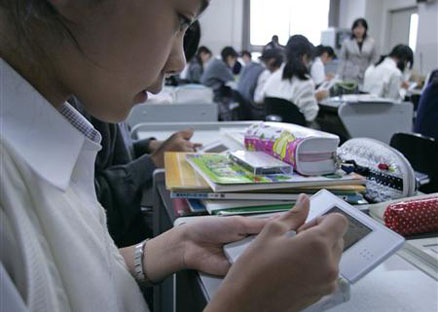Friday, June 7, 2013
Japanese Education System
Way more important than
the material, this
sentence judging is
simple but has a broad
meaning, even evidenced by the advanced countries,
we see the state
wrote japan. Since
the country was bombed by the Japanese in the city of Hiroshima and Nagasaki, the two cities was almost
razed to the ground. Japan experienced a
decline both in terms of administration, economics, education and others, it does not
make the Japanese surrender, Japanese rose
even fix from the
beginning of the country, to date country Japanese
rapidly evolving and
advancing, because education is concerned, we try see education Japanese with
education about the education system in America.
American and Japanese school structures differ
in many different ways. The first, and
most significant way, is that Japanese schools incorporate a national
curriculum created by the Japanese Ministry of Education. Thus, unlike the educational system in the
United States, in which each state determines its own curriculum, the federal
government decides on what each school must teach, how to teach it, and even
what books to teach it with. Therefore,
there are many implications for such a disparity in educational structure.
For
American schools, the fact that each state can come up with their own
curriculum means that states have autonomy as well as responsibility for what
each student learns. Consequently, each
state can then implement curricula in schools based on the resources available
to each state and what the state feels is the most important for its students
to learn. However, the major problem
with this system is the fact that the resources, namely money, available to
each state and district varies so much that students across the country receive
vastly different qualities of education.
Furthermore,
because students across the country are educated at such disparate levels
depending on the resources available to the school as well as the specific way
in which the school decides to comply with the state curriculum, high school
graduates from two different cities, not to mention states, may have strongly
dissimilar skills and knowledge. This
outcome is exceedingly true when comparing low-income urban schools with higher
income suburban schools in intra-state and inter-state analyses.
Therefore,
what the Japanese school is able to do by incorporating a nationalized system,
is make sure that every student receives the exact same education and thus the
system aims to decrease any gaps based on differential curricula. In the US, even though standardized testing
such as the ACT and the SAT are nationalized, the playing field is not. Nevertheless colleges expect students from
schools with such vastly dissimilar resources and curricula to compete
nationally when applying and consequently students from disadvantaged
backgrounds (socio-economic and educational) are the victims of the
inconsistency.
Therefore, while the Japanese schools are educating students at
a even, arguably superior, level, students in the US must find a way over the
hurdle of decentralized, state determined curricula. One study does show some cause for hope,
however, in that, "when US teachers use a curricula that parallels that of
Japan, US achievement is similar to that of Japan" (Westbury 24).
A second structural difference between
Japanese and American schools is simply the amount days students are in
school. Students in Japan spend,
"240 days a year at school, 60 days more then their American
counterparts" (Johnson 1996). Although critics of this claim have pointed
out that many of the extra days are spent engaging in activities geared more towards
cultural studies and field trips, students in Japan still spend significantly
more time in school than students in the US. Furthermore, traditional Japanese
schools also have a half day of instruction on Saturdays. As a result,
according to some estimates, in 13 years of schooling, US students receive
almost a year less than those in Japan.
The implications of this are that not only do Japanese students receive
more actual time per day engaging in focused, academic study, but they also
spend more days overall and therefore may have a clear advantage in terms of
practice, repetition, and breadth of knowledge.
Not
only that, but the Japanese school year is divided into 3 terms, without
extended breaks that may cause students to lose their skills in the absence of
regular academic instruction for prolonged periods of time (Johnson 1996). Thus, the problem in the US of students from
disadvantaged backgrounds gaining an essentially equal playing field over the academic
year and then losing most of what the gained over the summer, may not be a
factor in Japan because of the systemic difference in the academic calendar
(Lecture).
Finally,
although the US spends a considerable amount of money on education relative to
Japan, much of the funds that are appropriated are used for things other than
academics. These include funds for
transportation, food, athletics and custodians as well as money for programs
such as D.A.R.E. In fact, as much as 40%
of US curricula is devoted to nonacademic subjects (Abbeduto 380).
In contrast,
most Japanese students walk or ride their bikes to school and many traditional Japanese schools even
have students clean the school at the end of each day. Furthermore, although
students in Japan do participate in extra-curricular activities such as sports
after school, most are only allowed to choose one club. Additionally, most
students who are considering college perceive such activities as a hindrance to
their chances of passing the entrance exams that will pave the way to their
success (Johnson 1996).

Author: Mohammad
Mohammad is the founder of STC Network which offers Web Services and Online Business Solutions to clients around the globe. Read More →













